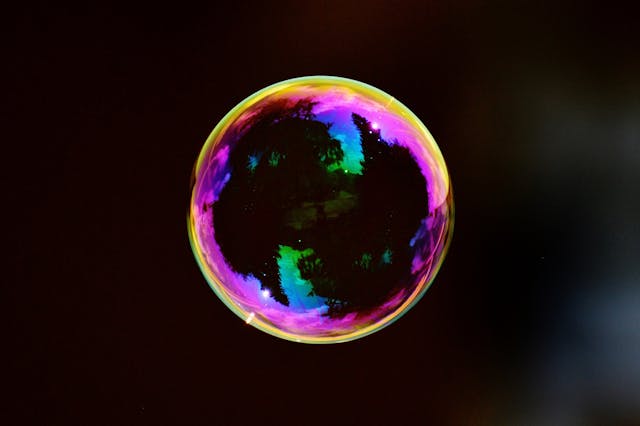
Why are bubbles round? Bubbles are round because the liquid they are made of is naturally trying to make the smallest area it possibly can, and that is a sphere.
A bubble is made when a liquid encloses a gas. If you are making soap bubbles, then that gas is the air. If you are looking into your soda, then the bubbles you can see are carbon dioxide. If you are staring into a volcano, then the bubbles you can see are probably containing carbon dioxide or sulfur dioxide. Whatever gas it is, you can be sure that if you have a bubble, then you must have some kind of gas. This gas will take up a certain volume, depending on how much gas is inside the bubble. The gas can be compressed, but only to a certain point. Compressing it more would take more pressure than the bubble can produce. That means the bubble is basically the gas container. So, why is it round?
There are three separate forces acting on the bubble. There is the pressure of the gas inside the bubble. It wants to expand, pushing the bubble outwards. Then there is the air pressure outside the bubble. The air outside the bubble weighs a lot and presses the bubble inwards. Then there is the surface tension of the liquid. Surface tension is the main reason why bubbles become round.
Inside a liquid, all of the molecules are attracted to all of the other molecules. If you have a cup of water, the water molecules in the water stick to each other due to something called cohesive force. This is where like molecules attract each other and stick together, and it is why molecules join to form substances. With the molecules in the center of the glass of water, they are attracted by all of the molecules on every side of them, and they are pulled equally in every direction at the same time. If you pull something in every direction at the same time, all of the forces cancel each other out, and you end up with a force of zero. The molecules don’t move. The molecules at the surface of the water don’t have anything above them. They are pulled to the sides and down, but nothing can pull them up. That means there is nothing to cancel out the downward force, and they are pulled inwards. This force pulls the liquid inwards until it finds the smallest surface area it can have.
In this situation, the shape with the smallest possible surface area is always going to be a sphere. This is because it can uniformly distribute all of the pressure inside it. If you had a square bubble or a triangular bubble, the gas inside the bubble is going to be spread out unevenly. You will have more gas in the center than you have in the corners, so you’ll have uneven pressure. If you did have a square bubble and you had lower pressure in the corners, the surface tension would pull on the bubble in the corners until they moved far enough in that all of the pressure inside the bubble was equalized. This shape would be a sphere.
The surface tension in a bubble is very strong, but only for as long as all of the molecules are attached to each other. If you break the surface tension by bursting the bubble, it will disappear. It doesn’t instantly disappear, and if you watched it on a high-speed camera, you would be able to see what happens, but it bursts too quickly for us to see. Remember, our eyes can only process 12 individual images a second. When you burst the bubble, the surface tension between some of the molecules is broken. The molecules are now pulled more strongly down and to the side. They get pulled apart, and this starts a chain reaction. More molecules are pulled out of the way, the surface tension is broken, and the gas inside the bubble, which was held under slightly high pressure, escapes out of the bubble. If you had a colored gas in the bubble, you would be able to see where it went.
Water bubbles exist inside liquids, but you couldn’t make a water bubble in the air because the surface tension of water is too strong, and the bubble would collapse. You can get better bubbles if you put soap in your water because the soap lowers the surface tension of the water and lets the bubble stretch more. This means you can put in more gas and make the bubbles bigger. They are also stronger. And this is what I learned today.
Sources
https://annex.exploratorium.edu/exploratopia/activity_bubbles.html
https://en.wikipedia.org/wiki/Surface_tension
https://en.wikipedia.org/wiki/Cohesion_(chemistry)
https://science.howstuffworks.com/why-do-bubbles-pop.htm
Photo by Pixabay: https://www.pexels.com/photo/bubble-illustration-35016/
